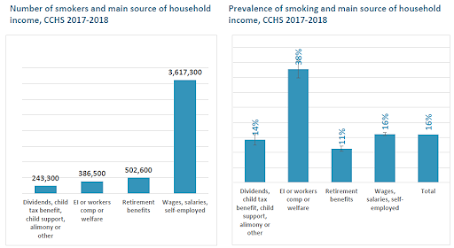Earlier this summer, Statistics Canada released data files for the 2017-2018 Canadian Community Health Survey. This post is one of an occasional series which reviews this data for information on smoking patterns in Canada. Today's post is the first to look at the relationship between income and smoking behaviour.
Inequities in income and smoking behaviour continue
In recent decades the relationship between economic disadvantage and smoking has been well established. A clear demonstration of this is in the smoking rates of each household income quintile (one-fifth of households). Those in the poorest households are 1.8 times as likely to smoke as those in the wealthiest: only 12% of Canadians in the highest group say they smoke cigarettes compared with 22% in the poorest.
The CCHS has reported on income quintiles since 2005. Although smoking rates have fallen in all household income groups over this period, the differences among them have not. In 2005, there was an 8 percentage point difference in smoking rates between lowest and highest income quintiles (27% vs 19%), while in 2017-2018, the gap was 9 percentage points (21% vs. 12%).
Those in Canada's poorest one-fifth of families are 70% more likely to smoke than are those in Canada's one-fifth richest (RR=1.7).
This is is not because poorer Canadians are more likely to experiment with or become smokers. Canadians in all income levels are generally equally likely to have never smoked (this is less true for younger Canadians). Smokers in higher-income households, however, are more likely to quit than are those in poorer homes. For every 100 Canadians who have ever smoked more than 100 cigarettes, 70 in the highest income quintile will have quit, while only 57 in the lowest quintile will have done so.
Although smoking rates are higher among poorer Canadians, it is not true that most smokers are poor.
Statistics Canada provides information on household income brackets in increments of $20,000, with the highest category being "$80,000 or more". More than half (55%) of Canadian smokers live in families with household income over $60,000.
Families dealing with food insecurity are also affected by nicotine addiction. However, most smokers are not facing food insecurity.
The Canadian Community Health Survey is an annual survey conducted by Statistics Canada. Every two years, the Public Use Micro File is made available with information based on surveys of the health behaviours and status of about 100,000 Canadians over the age of 12.
Links to data referred to in this post:
- CCHS 2017-2018: Smoking behaviour and income, source of income and food insecurity (by age and sex)
- CCHS 2017-2018: Smoking behaviour and household income quintiles (by age, sex and province)
- CCHS 2005 to 2017-2018: Historic data - Smoking behaviour and household income quintiles .
- Other reports or resources




